People are like donuts–topologically, that is. My daughters and I explored this strange statement with a clay figure modeled around a pen (and then I pulled the pen out). What is topology?
Topology (Greek topos, “place,” and logos, “study”) is the branch of mathematics that studies the properties of a space that are preserved under continuous deformations. Topology grew out of geometry, but unlike geometry, topology is not concerned with metric properties such as distances between points. Instead, topology involves the study of properties that describe how a space is assembled, such as connectedness and orientability.
Here are the photos illustrating our adventure:
As you can see, humans have a hole running all the way through them, as do donuts. The above clay model oversimplifies the hole running through humans, which is not straight, but twisting and convoluted.
Nonetheless, we each have a hole running all the way through our bodies. That makes people the topological equivalent of donuts. In fact, all mammals are the the topological equivalent of donuts. This equivalence can be seen in the food tube of the giraffe, for example.
I took this extraordinary photo at the Field Museum in Chicago..
.
.
.
.
.What else is the topological equivalent of a donut? A coffee cup, which you can see in this animation at Wikipedia.
Therefore, you can sometimes see the most extraordinary thing at a donut store. You can find “big” donuts shopping for little donuts.
.
.
.
.
.
Here, for example, are my daughters getting ready to buy some Sunday morning donuts (photo taken in 2002).

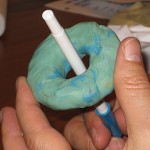
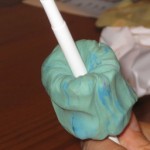
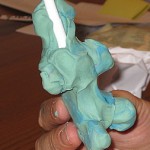
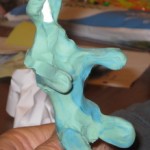

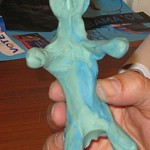
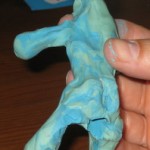
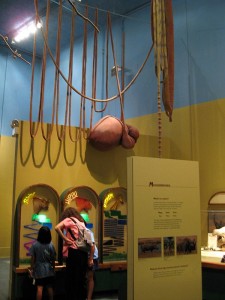



And bagels are like donuts, and we eat bagels every Sunday. . .
Does that make me and my family a bunch of cannibals? ONOZ!
Build them a kleinbottle… (3 dimensional mobius strip)
http://www.youtube.com/watch?v=E8rifKlq5hc
Actually i studied about topology, it is vital for making maps (via computer database). We things like satellite gps data to determine (for example) the best place to build a Starbucks. Any surface (topography) can be accurately modeled using just points and lines if you know *exactly* how they connect.
http://webhelp.esri.com/arcgisdesktop/9.2/index.c…
Back in his undergrad days, my father was shocked when his roommate suggested that a human is basically a glorified digestive tract with a mouth at one end and an anus at the other, and a few ancillary systems stuck on around it for support and reproduction. The idea apparently burrowed into his psyche, for he passed this bit of wisdom on to me when I was getting too full of myself in my teens.
To arrive at this point via topology was a surprise; an enjoyable reach.
The animation on Wikipedia was nice. I remember reading about the donut transforming into a mug in a math book when I was a kid, but the explanation was poor and I didn't get it then (or maybe I just didn't get it, period).
Ben, you can also knit a Klein bottle:
http://knitty.com/ISSUEsummer06/PATTkleinbottle.h…
And here is an interesting article about the use of knitting and crocheting to demonstrate mathematical questions with physical models:
http://www.msnbc.msn.com/id/25011806/
I just recently had a talk with one of my former roommates, an architect, and he told me that he had wondered if he could use knitting for some 3-dimensional object he was interested in.
Does this mean that if you run in circles you become a hyper-torus? ( like a fourth dimensional donut.
mmmmmmmmm….. Donuts!
If people are tori, think about linked Borromean rings.
I poop, therefore I, donut.
Thanks for posting this interesting relation we have with donuts. I have been aware of it since my youth & still have not reached any conclusions from it suitable for public dissemination. However, as we require oxygen to live, we are more like gas powered donuts.